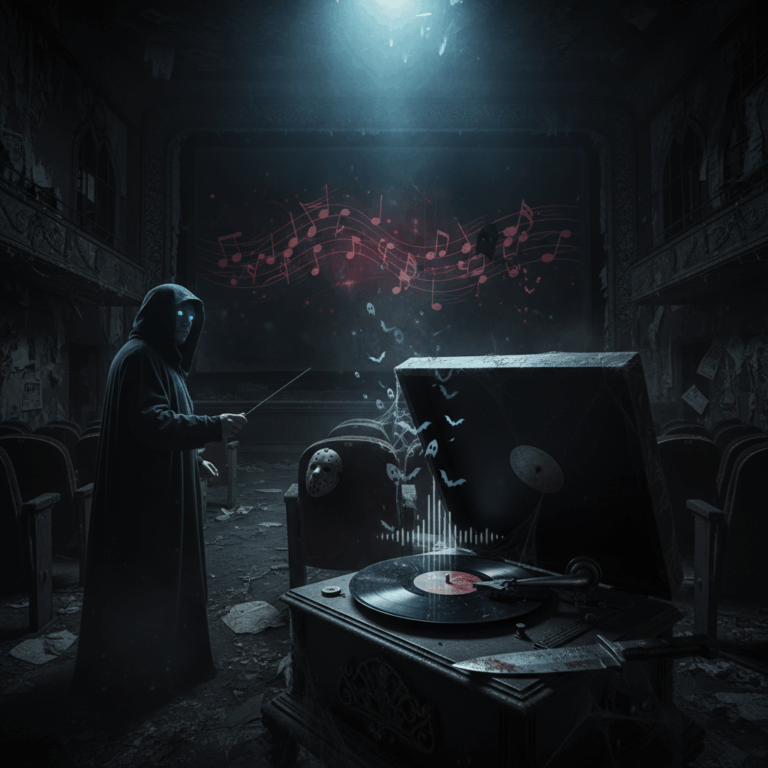The impact of music on horror films
Music in horror films is essential for amplifying fear and tension. Soundtracks transform simple scenes into unsettling and memorable moments.
From classical composers to modern innovators, the use of sound has proven essential to immersing the viewer in intense and terrifying atmospheres.
The combination of precise melodies and sound effects manages to transform the visual experience into a much deeper and more terrifying experience for the audience.
Transforming scenes through soundtracks
Soundtracks radically alter the perception of a scene, intensifying emotions and creating anticipation. Without music, many scenes would lose their emotional impact.
For example, the shower scene in "Psycho" becomes distressing thanks to the sharp violins that increase the tension in an almost visceral way.
The music acts as an invisible character that guides the viewer, accentuating key moments and making the fear palpable and immersive.
Creating tense and fearful atmospheres
The music in horror films is designed to instill anxiety and establish an ominous atmosphere. Subtle variations in sound create a constant tension for the viewer.
Minimalist themes, haunting lullabies, or discordant sounds create an atmosphere charged with fear, anticipating dangers and increasing unease.
This music contributes to creating an emotional state where the viewer feels the tension lingering, even after the film has ended.
Iconic soundtracks from horror films
Horror film soundtracks have marked a turning point in cinematic history. They are capable of intensifying fear with memorable and unique compositions.
This section highlights some legendary compositions that revolutionized the genre, from tense melodies to minimalist themes that remain in our memory.
These masterpieces demonstrate that music is not just an accompaniment, but an indispensable element for creating fear and unsettling atmospheres.
“Psycho” and the sonic tension of Bernard Herrmann
The soundtrack for “Psycho” is famous for its masterful use of violins, which create unbearable tension in key scenes, especially the shower scene.
Bernard Herrmann succeeded in making the music double the impact of the scene, provoking a visceral reaction in the viewer. This composition is a paradigm of sonic horror.
His technique uses sharp, repetitive chords that induce anxiety and fear, making him an essential reference for future composers and films of the genre.
“Rosemary’s Baby” and its haunting lullaby
In “Rosemary’s Baby”, Krzysztof Komeda used a lullaby performed by Mia Farrow to accentuate the underlying horror through a seemingly innocent melody.
This children's song, with its whispering voice, transforms into a symbol of evil and fear, generating a disturbing feeling that intrigues and frightens.
The contrast between the melodic sweetness and the sinister context creates a unique atmosphere that reinforces the psychological terror of the film.
“The Exorcist” and the song “Tubular Bells”
Mike Oldfield's "Tubular Bells" theme, originally outside of film, became emblematic for its hypnotic presence in "The Exorcist", fusing the delicate and the dark.
This piece of progressive rock helps to build a supernatural and profound atmosphere, and is today an unmistakable icon of cinematic horror.
Its repetition and combination of instruments generate tension and mystery, trapping the viewer in a state of constant unease throughout the film.
Minimalism in John Carpenter's "Halloween"
The minimalism in the “Halloween” soundtrack uses a simple, repetitive melody that creates a sharp, ominous atmosphere around Michael Myers.
John Carpenter combined synthetic percussion and a catchy theme that serves as a musical shadow of the killer, increasing the sense of latent danger.
This music acts as an emotional guide, anticipating terror and keeping the audience in constant tension, even in seemingly calm scenes.
Sound innovations in horror
Horror films have explored new ways to generate fear through unconventional sounds. These innovations amplify the sense of dread and surprise in the audience.
Composers and conductors have used strange noises and unexpected musical pieces to create a unique atmosphere that goes beyond traditional melody.
This approach transforms sound into a central element, capable of evoking a more visceral and psychological terror, expanding the boundaries of the genre.
Use of unconventional sounds in “The Texas Chainsaw Massacre”
In "The Texas Chainsaw Massacre," the soundtrack dispenses with classical musical instruments and opts for noisy effects such as screams and metallic clangs to cause discomfort.
This sound choice intensifies the unease and makes the horror feel more real and close, generating a sound impact that sharpens the experience of terror.
The use of industrial and dissonant sounds turns the music into an extension of the violence, reflecting the brutality shown on screen.
Musical association and psychological horror in “The Silence of the Lambs”
“The Silence of the Lambs” did not create original music for horror, but it knew how to use the theme “Goodbye Horses” to reinforce the psychological horror in a key scene.
This song transforms a disturbing moment into a sonic symbol of inner fear, demonstrating how music can intensify the emotional and psychological impact.
The association between this piece of music and the scene creates a haunting atmosphere that lingers in the viewer's memory long after the film.
Key elements in horror soundtracks
Horror soundtracks manipulate the viewer's perception, creating a constant anticipation of imminent danger that amplifies the fear of the unknown.
Through strategic sounds and calculated silences, the music anticipates threats, making the audience feel continuously alert during the screening.
The ability to alter perception is essential in these compositions, since fear arises from what the listener imagines before the action occurs.
Manipulation of perception and anticipation of danger
Soundtracks play with the mind by using dissonant tones and repetitions that generate nervousness, preparing the audience for a terrifying event.
The suspense grows with musical cues that suggest movement or presence without showing it directly, making the fear based on uncertainty.
This sonic anticipation creates an emotional bond that keeps the viewer in suspense, increasing the effectiveness of the visual and narrative scares.
Persistence of fear and tension after projection
The impact of a horror soundtrack lasts beyond the film, leaving sonic echoes that continue to evoke fear in the viewer's mind.
Eerie melodies and effects are etched into memory, and can trigger distressing feelings when recalling the experience or hearing similar sounds.
This persistence contributes to the terror not ending with the viewing, prolonging the feeling of unease and increasing the intensity of the memory.






